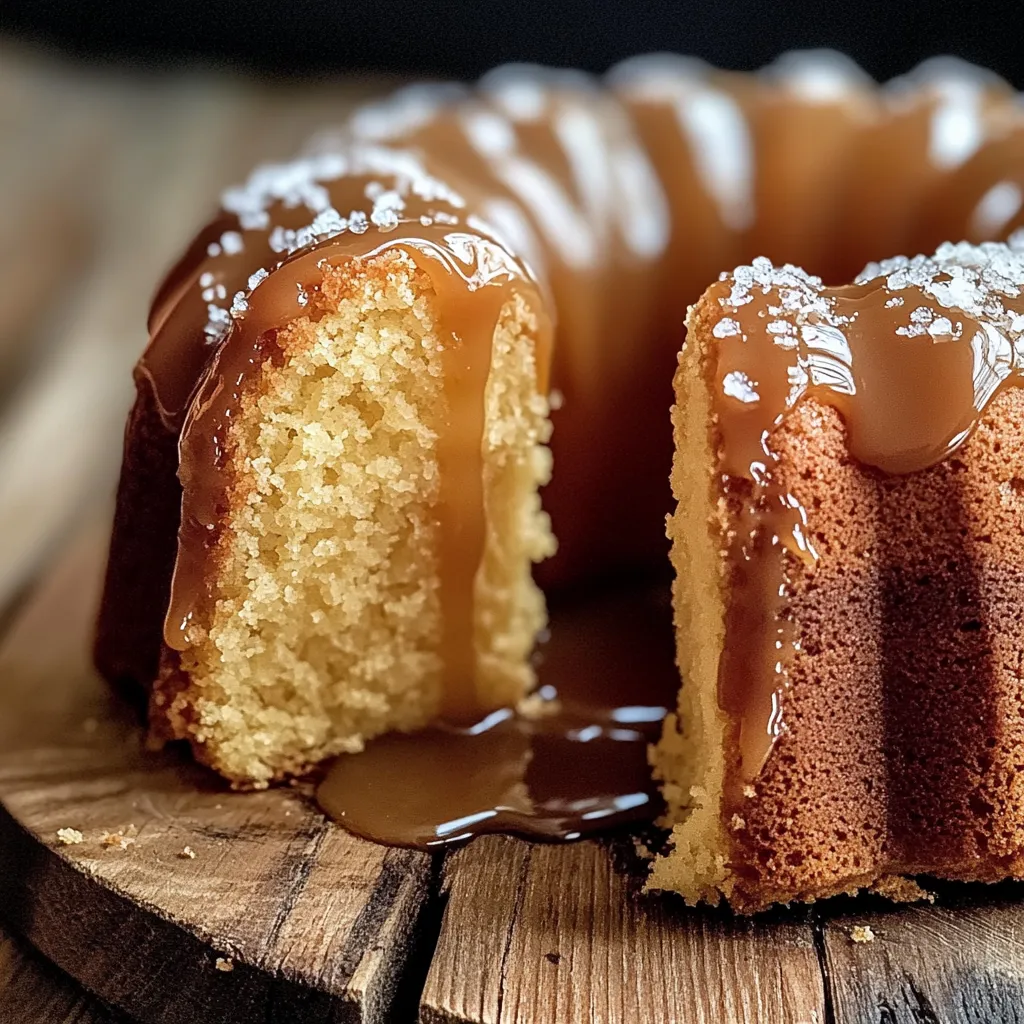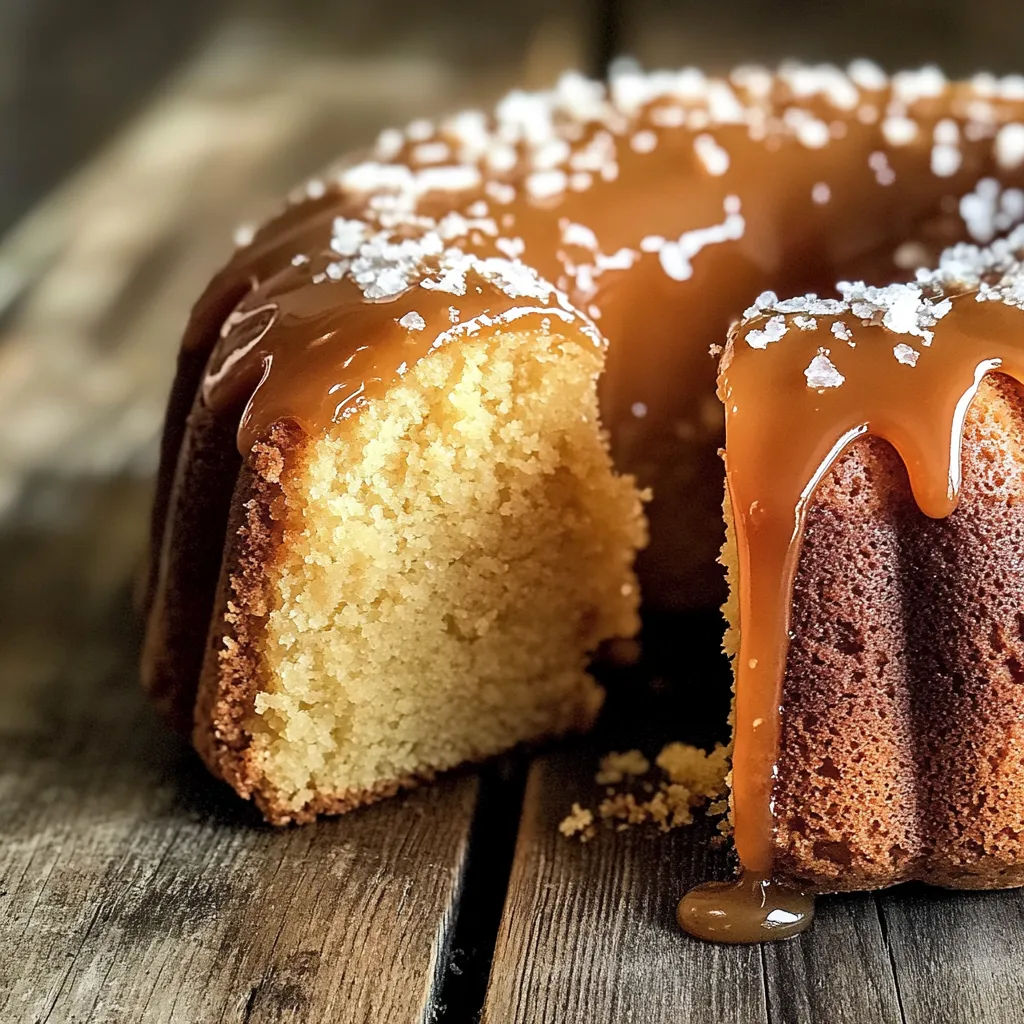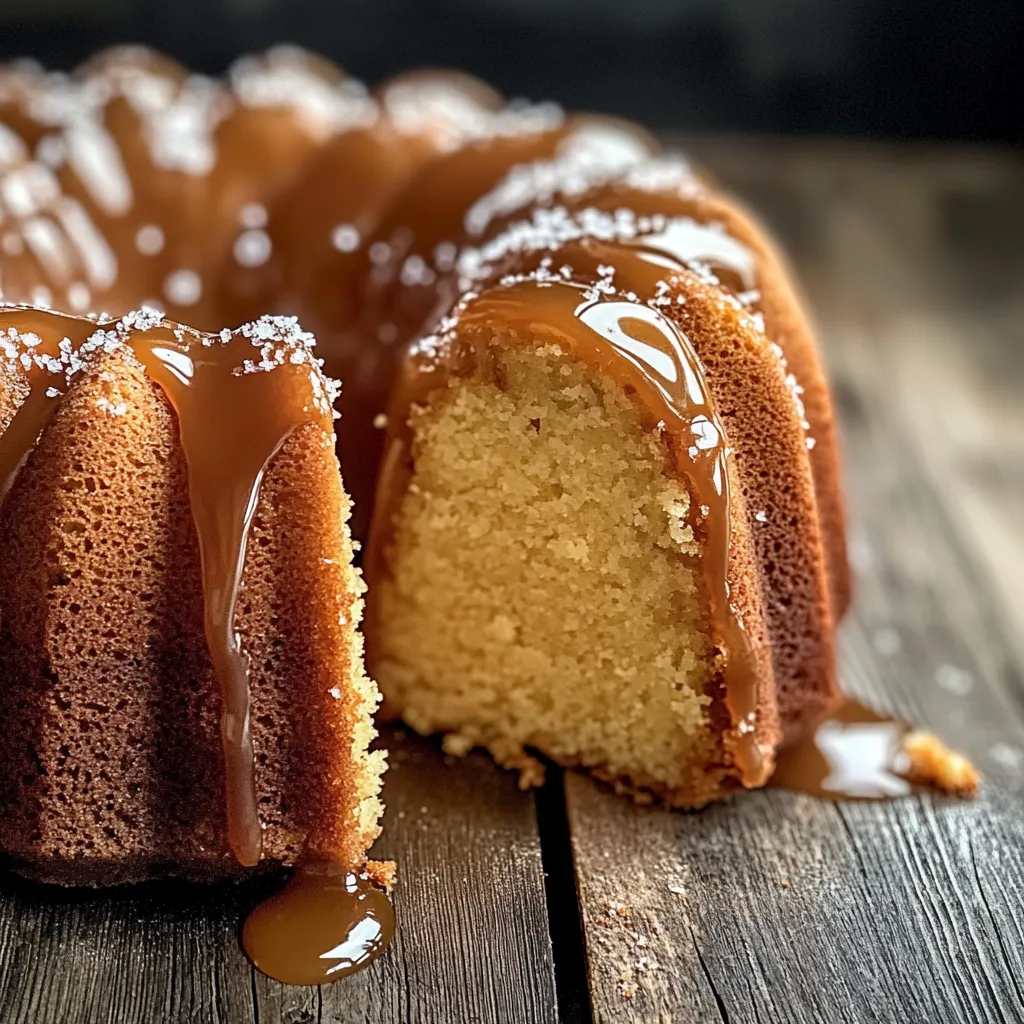 Pin it
Pin it
This Salted Caramel Kentucky Butter Cake brings together all the things we crave in a dessert: deep buttery flavor, soft tender crumb, and a caramel glaze that soaks into the cake and finishes with a delicate salty edge. It's the kind of cake that quietly disappears slice by slice—and no one ever complains about seconds.
Every time I make this cake, I'm reminded why it's such a reliable favorite. That glossy salted caramel glaze always draws everyone in, and it's so satisfying watching it seep into the cake. I've even taken it to holiday dinners where people skip the pie just for a second piece of this.
What You'll Need
- All-purpose flour: This is the base of the cake, offering structure. Make sure it's sifted to keep the crumb light.
- Granulated sugar: Adds sweetness and contributes to the tender texture.
- Unsalted butter: The star of the show. Let it soften so it creams properly. Its flavor runs through every bite.
- Large eggs: They add richness and stability. Room temperature eggs mix more smoothly into the batter.
- Vanilla extract: A background note that enhances the caramel and butter flavors.
- Baking powder: Lifts the cake just enough to keep it fluffy, not dense.
- Salt: Balances the sweet and brings depth. Don't skip it!
- Whole milk: Provides moisture and helps everything blend together. Use room temperature milk for best results.
For the glaze:
- Unsalted butter: Forms the base of the caramel sauce. Melt it gently to avoid browning.
- Brown sugar: Deepens the flavor of the glaze. Packed tightly into your measuring cup.
- Heavy cream: Adds smoothness and body to the glaze. Don't substitute it.
- Vanilla extract: Rounds out the richness of the caramel.
- Sea salt: A finishing touch that brings contrast and elevates the overall taste.
Mixing the Batter
- Preparing the oven:
- Start by preheating your oven to 350°F. Generously grease a 9×13-inch pan and dust it with flour. This ensures a clean release once baked.
- Creaming butter and sugar:
- In a large bowl, beat the softened butter with the sugar until the mixture becomes pale and fluffy. This step helps the cake rise and gives it that irresistible light texture.
- Incorporating the eggs:
- Add the eggs one at a time, blending after each addition. This method ensures each egg is fully absorbed and prevents the batter from curdling.
- Adding vanilla:
- Stir in the vanilla extract. It's a small addition, but it adds warmth and depth to the batter.
- Mixing dry ingredients:
- In a separate bowl, combine the flour, baking powder, and salt. Whisk them together so they incorporate evenly into the batter.
- Combining dry and wet:
- Add the dry mixture to the butter mixture in batches, alternating with the milk. Begin and end with the flour mix. Stir gently just until the batter is smooth and no dry spots remain.
- Getting ready to bake:
- Pour the batter into your prepared pan. Smooth the top evenly with a spatula so it bakes uniformly.
- Baking:
- Place in the center of your oven and bake for 40 to 45 minutes. A toothpick should come out clean or with moist crumbs attached. Let it rest in the pan for about 10 minutes before turning out onto a wire rack.
Caramel Glaze Magic
- Melting the butter:
- In a medium saucepan, melt the butter over medium heat. Stir occasionally to keep it from browning or separating.
- Adding the brown sugar:
- Stir in the packed brown sugar. Let the mixture come to a gentle simmer. This should take 2–3 minutes—just enough to dissolve the sugar and bring out that caramel flavor.
- Finishing the glaze:
- Once it's bubbling, remove it from the heat and stir in the heavy cream, vanilla extract, and sea salt. The mixture will foam a bit, so keep stirring until smooth and glossy.
- Drizzling over the cake:
- While the glaze is still warm, pour it slowly over the cooled cake. Let it sink into the cracks and edges. Don't worry about perfection—those drips down the side make it even more tempting.
 Pin it
Pin it
This is one of those cakes where every detail makes a difference. When I use high-fat European butter, people always ask what makes it taste so good. And letting the glaze soak into a warm (not hot) cake? That's the secret to a perfectly moist texture.
Serve It Your Way
This cake stands beautifully on its own, but if you want to get creative:
- Serve it with a scoop of vanilla bean ice cream for the ultimate dessert duo.
- Add a sprinkle of flaky sea salt just before serving to enhance that salted caramel contrast.
- Pair it with hot coffee or a glass of cold milk—it brings out the buttery richness.
Fun Twists to Try
Want to mix things up a bit? Try these variations:
- Bourbon Glaze: Swap the vanilla in the glaze for a tablespoon of bourbon for a Kentucky-inspired kick.
- Nutty Crunch: Add chopped pecans or walnuts to the batter for texture.
- Mini Bundt Style: Bake the batter in mini Bundt pans for adorable individual servings.
How to Store and Reheat
This cake keeps incredibly well, which makes it ideal for making ahead.
- At Room Temperature: Store covered for up to 3 days. It stays moist and flavorful.
- In the Fridge: Wrap tightly and keep for up to a week. Bring to room temperature before serving.
- Freezing: Freeze the cake without glaze. Wrap it in plastic and then foil. Thaw at room temperature, glaze, and enjoy.
- To Reheat: Warm slices in the microwave for 10–15 seconds if you want that gooey caramel feel again.
There's something special about how this cake brings comfort and celebration together. It's not fancy or fussy—it just hits the right notes of buttery, sweet, and salty in every bite. Whether it's for a birthday, potluck, or just because, it always delivers.
 Pin it
Pin it
Frequently Asked Questions
- → Can I make this cake without a bundt pan?
- Yes, you can bake this in a 9x13 inch rectangular pan instead. The baking time will be shorter (around 35-40 minutes), so start checking for doneness earlier. For the glaze application, poke holes all over the surface and pour the glaze evenly over the top while the cake is still warm.
- → What can I substitute for buttermilk?
- If you don't have buttermilk, you can make a quick substitute by adding 1 tablespoon of white vinegar or lemon juice to 1 cup of regular milk. Let it sit for 5 minutes until it slightly curdles. Alternatively, you can use 1 cup of plain yogurt thinned with 2 tablespoons of milk.
- → Why is my cake sticking to the bundt pan?
- To prevent sticking, thoroughly grease every nook and cranny of your bundt pan with butter or shortening, then dust with flour. Make sure to tap out excess flour. Also, allow the cake to cool for exactly 10 minutes before inverting - any sooner and it might fall apart, any later and it might stick.
- → Can I freeze this Kentucky Butter Cake?
- Yes! This cake freezes beautifully. For best results, freeze the cooled cake before adding the glaze. Wrap it tightly in plastic wrap, then aluminum foil, and freeze for up to 3 months. Thaw overnight in the refrigerator, then bring to room temperature and add the freshly made glaze before serving.
- → Why is my caramel glaze grainy or crystallized?
- This typically happens when sugar crystals form during cooking. To prevent this, make sure to melt the butter first, then add the brown sugar and stir gently until dissolved before adding other ingredients. Avoid stirring too vigorously once the mixture comes to a simmer, and don't scrape down the sides of the pan.
